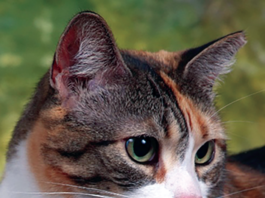The Team Approach to Success
Steffi Loomis awoke in the middle of the night to the sound of painful meows from Dave, her normally mellow 16-year-old female cat with a male name. When Loomis turned on the light, she discovered bloody diarrhea and vomiting and her orange tabby getting weaker and sicker by the minute. Loomis, who lives in New Canaan, Conn., contacted the veterinarian, who advised her to take Dave immediately to Cornell University Veterinary Specialists in nearby Stamford, Conn. CUVS, the largest university-affiliated veterinary referral service in the country, has been referred to as the Mayo Clinic of veterinary medicine. Loomis rushed Dave there, and a team of specialists quickly worked to save her life.
‘Stranger Danger’? It’s Genetic
Scout was camped out under the sofa, refusing to eat. The cat’s fearful behavior began when Richard and Sue-Ellen Stillwell Jones’ daughter and her husband came to visit. When they walked into the Fort Collins, Colo., home, Scout looked terrified and disappeared under the sofa. She didn’t emerge for most of the day, and Jones was afraid that the stress of having strangers in the home, combined with her lack of appetite, would cause the cat’s pancreatitis to flare up. Scout’s fear of strangers isn’t uncommon, says Katherine A. Houpt, VMD, Ph.D., behavior specialist and professor emeritus at the Cornell University College of Veterinary Medicine. It’s a natural reaction to people who don’t smell familiar. “It’s not surprising that cats are fearful,” she says.
Quick Action at Home Can Stop the Growth of Hot Spots
Within hours, you notice that your cat has developed a red, raw, damp, hairless spot and it’s spreading. It looks like a scrape you’d get falling off your bike. The likely diagnosis: a hot spot. Cats with underlying skin diseases — usually allergies — are candidates for quickly developing hot-spot-type lesions, says dermatologist William H. Miller, VMD, Medical Director of the Companion Animal Hospital at the Cornell University College of Veterinary Medicine. Allergic animals feel itchy but may focus on a particular spot as they lick, rub, scratch, and bite, and in the process can pull out fur. The bare patch can quickly grow in size. What to do?
When a Marauding Bee Strikes
Cats, even those who live strictly indoors, are never completely safe from venomous insects. All it takes is a wayward bee or wasp to slip through an open door or window and catch your cat’s attention. His innate prey drive can kick into gear as he leaps and tries to swat and eat the flying insect. In reaction, the bee delivers a painful sting. “Most bee or wasp stings occur on a cat’s front paw or face,” says Elisa Mazzaferro, DVM, Ph.D., who specializes in emergency and critical care at the Cornell University Veterinary Specialists Center in Stamford, Conn.
Pursuing a Cure for Breast Cancer
Eighty to 90 percent of mammary tumors in cats are cancerous and can spread as rapidly as aggressive breast cancer does in humans. Researchers at the Cornell University College of Veterinary Medicine are hoping to improve treatment of mammary adenocarcinomas, with the long-term goal of a cure. Their pioneering focus: the role of stem cells in the disease. Gerlinde Van de Walle, DVM, Ph.D., Assistant Professor of viral pathogenesis and stem cell biology at Cornell’s Baker Institute for Animal Health, is working to identify adult mammary stem cells (MaSC) in both healthy and malignant feline and canine mammary gland tissues.
The Benefits of a Higher-protein Diet
Conventional wisdom has long held that cats need less protein as they age. The truth is exactly the opposite, says Joseph Wakshlag, DVM, Ph.D., Associate Professor of Nutrition at the Cornell University College of Veterinary Medicine. “What we realize in geriatrics is that nobody pays much attention to muscle mass. We’re starting to realize you lose muscle mass as you age — human, dog, cat. You can’t reverse it,” he says. “You have to lift weights to maintain current muscle mass, but it’s hard to get a cat to lift weights.”
The Year-Round Threat of Ticks
Ticks pose a year-round threat to cats in every state — even if yours spends virtually all his time indoors. These minute arachnids have survived for millennia and often go undetected as they feed on their host’s blood, often causing serious illness and even death. “The major problem with ticks is that they are vectors for various infectious agents,” says dermatologist William H. Miller, VMD, at the Cornell University College of Veterinary Medicine.
Study Puts Feral Cats in the Spotlight
A study published earlier this year that found free-ranging cats annually kill an estimated 2.4 billion birds and more than 20 million mammals drew heated responses from both wildlife and cat advocates.Lost in the controversy was the plight of outdoor cats themselves. They suffer from exposure to extreme weather and more injuries caused by cars, dogs, other cats and wild animals than those who live indoors, says Bruce G. Kornreich, DVM, Ph.D., Associate Director for Education and Outreach at the Feline Health Center at the Cornell University College of Veterinary Medicine.
When a Sudden Disaster Strikes
Disaster preparedness isn’t only for earthquakes and hurricanes. It’s also vital for everyday occurrences, such as an extended power outage or sudden wildfire racing over the hill. Every 23 seconds, a fire department rushes to a fire somewhere in the U.S., according to the National Fire Protection Association. Are you ready?
The Biggest Mistake in Giving Treats
Treats provide welcome rewards for good behavior, but their overly generous use can contribute to obesity. One reason is that owners don’t count treats as calories. “But the bigger problem is a multiple-person household in which every time someone walks by, they give the cat a treat,” says Joseph Wakshlag, DVM, Ph.D., Associate Professor of Nutrition at the Cornell University College of Veterinary Medicine.
Why Do They … Chase Lasers Beams?
Cats love to chase lasers’ points of light, twirling, leaping, pouncing. They engage in the behavior with gleeful abandon for one simple reason: “The jumpy, erratic movement of the light beam can stimulate predatory-like play behavior,” says Pamela Perry, DVM, Ph.D., a lecturer in animal behavior at the Cornell University College of Veterinary Medicine.
The Many Roles of Whiskers
The old-fashioned term “the cat’s whiskers” means the height of perfection. It was popular in the ’20s, along with “the cat’s meow.” Debate ensued regarding the origin of the phrases, but people who used them certainly understood the unique capabilities of your cat’s most sensitive hairs.

















